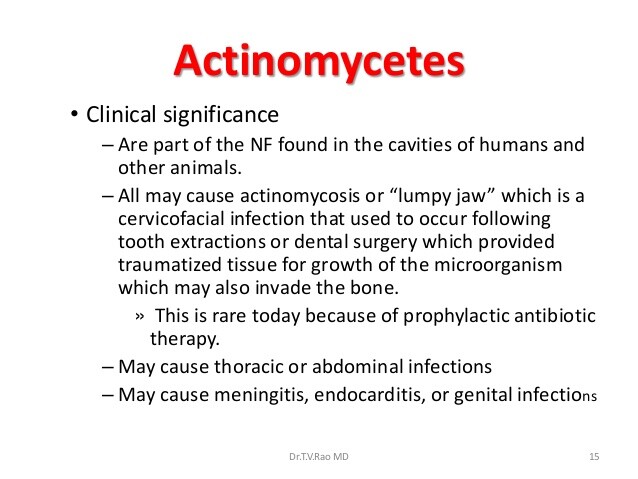Actinomycetes are variably acid-fast, gram-positive bacilli that are sometimes filamentous and branched.
Originally thought to be fungi due to their hyphae-like appearance, they are now recognized as bacteria based on their cell wall components, reproduction by fission without sporulation or budding, inhibition by antibacterial agents, and molecular phylogenetic analysis. The actinomycete chromosomes contain a high content of guanosine and cytosine.
The actinomycetes include the genera Mycobacterium and Corynebacterium, which are discussed in site and site, respectively.
The actinomycetes also include the genera Nocardia, Actinomyces, Rhodococcus, Tsukumurella, Gordona, Actinomadura, and Streptomyces, as well as the Whipple’s disease bacillus Tropheryma whippelii.
Of these, members of the genus Nocardia are the most significant from a clinical standpoint, followed by organisms from the genus Actinomyces. The other actinomycetes discussed in this SITEare less common causes of disease in humans.
OTHER ACTINOMYCETES
Species of the Rhodococcus genus have occasionally been implicated in human disease. Rhodococcus spp. differ from Nocardia spp. in that they do not produce aerial hyphae. Gordona and Tsukumurella, formerly classified in the Rhodococcus genus, are also rare causes of human disease. Rhodococcus equi, the species that is most commonly implicated in human disease, is found in soil and in the intestinal contents of grazing herbivore animals.
Because most infections have been associated with immune system dysfunction, there has been an increase in reported cases of R equi infection since the onset of the HIV epidemic in the 1980s.
Pulmonary disease is the most common clinical manifestation of R equi infection, and occurs after inhalation of the organisms. Cutaneous infections, bacteremia, and catheter-associated sepsis have also been reported. Prolonged combination therapy with erythromycin or imipenem plus rifampin is currently the treatment of choice. Intestinal R equi disease may mimic Whipple’s disease.
The disease that bears George Whipple’s name affects primarily white, middle-aged males and causes arthralgias, abdominal pain, diarrhea, weight loss, fever, and lymphadenopathy. The causative agent, T whippelii, is an actinomycete that is difficult to cultivate in vitro.
The gastrointestinal tract and its lymphatic drainage, the heart, and the CNS are the sites most commonly involved by this chronic, systemic disease.
The diagnosis can be made by detection of numerous periodic acid-Schiff reagent (PAS)-positive macrophages within the intestinal lamina propria or by detection of the characteristic bacilli or their DNA within affected tissues or fluids, using electron microscopy or the polymerase chain reaction, respectively. Most patients respond to antibiotics; the recommended regimen consists of a combination of parenteral penicillin and streptomycin for 2 weeks, followed by = 1 year of TMP-SMX. If untreated, the disease is fatal. Relapse within the CNS occurs in approximately one-third of patients, despite treatment.
The genus Streptomyces consists of a plethora of species of which most are considered saprophytes; they are found throughout the environment. Streptomyces spp. are primarily soil inhabitants.
Three species, S somaliensis, Streptomyces paraguayensis, and Streptomyces anulatus, have been implicated in human disease, primarily in the formation of actinomycetomas. S somaliensis and S paraguayensis are rarely, if ever, found in the United States. They primarily inhabit Latin America, although S somaliensis is also known to cause disease in the arid regions of Africa and Arabia. S anulatus, on the other hand, has been associated with lung disease and sepsis, brain abscess, and panniculitis, as well as cervical lymphadenitis in an immunocompromised patient in the United States.
Isolation of the streptomycetes should follow procedures used for the isolation of nocardiae. Colonies are usually glabrous or waxy and heaped. Definitive identification usually is extremely difficult. Streptomycin in combination with either dapsone or TMP-SMX has been suggested as treatment for infection with Streptomyces spp.
BOX 1. Nocardiosis in Adults and Children
Nocardiosis
- Invasive pulmonary disease and dissemination, especially to CNS, but also to kidney, skin, bone, and retina, more common in immunosuppressed patients
- Cutaneous infections, ie, cellulitis, abscess, pyoderma, mycetomas
BOX 2. Treatment of Nocardiosis
First Choice
- TMP (160 mg)-SMX (800 mg) IV or PO every 6 h for 6-12 m1
Second Choice
- Oral agents: minocycline (at 100-200 mg twice a day), amoxicillin-clavulanate, or fluoroquinolones such as ciprofloxacin or ofloxacin
- Parenteral agents: imipenem, amikacin, or third-generation cephalosporins
1) CNS disease and immunosuppressed patients should receive = 12 mo of therapy. TMP-SMX should be used in combination with imipenem, amikacin, or third-generation cephalosporins for CNS disease and in immunosuppressed patients who do not respond to single-agent therapy.
BOX 3. Actinomycosis in Adults and Children
More Common
- Cervicofacial, especially perimandibular region (~ 50% of cases)
- Draining sinus fistulas common
Less Common
- Thoracic (~ 15%)
- Abdominal disease (~ 20%)
- Pelvic disease associated with intrauterine device use
BOX 4. Treatment of Actinomycosis
First Choice
Penicillin G, 18-24 million U IV every day in 6 divided doses for 2-6 w, followed by penicillin VK, 250-500 mg PO 4 times a day for at least 6-12 m
Second Choice
Penicillin-Allergic
Tetracycline, minocycline, erythromycin, or clindamycin (standard doses not available)




